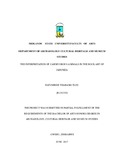Please use this identifier to cite or link to this item:
https://cris.library.msu.ac.zw//handle/11408/3320| Title: | The interpretation of carnivorous animals in the rock art of Jahunda | Authors: | Tlou, Hatumisoe Thabang | Keywords: | Rock art Animals Carnivorous animals Zimbabwe |
Issue Date: | 2017 | Publisher: | Midlands State University | Abstract: | The rock art of southern Africa, Zimbabwe included, depicts a variety of symbols and characters that portray humans, animals, ceremonies and motifs of a spiritual nature. A lot of explanations have been proposed as to the function and meaning of rock art in general with the most accepted explanations linking the art to shamanism. This hypothesis (shamanism) argues that rock art paintings were created by shamans depicting dreams or visions of an individual seeking medicine or participating in a particular ritual. This hypothesis largely relied on an elucidation of the significance of the eland (and in some cases, other herbivorous animals such as the kudu) in the rock art of the hunter-gatherers thereby downplaying the significance of other animals especially carnivorous animals. Field surveys in the Jahunda have shown how carnivorous animals such as the jackal, hyena, leopard and lions are a common occurrence in the rock art of the area thus the carnivorous animal paintings are investigated under the assumption that their depiction attests to their significance in the cosmology of the artists. This study investigates differences in motif representation as well as style of the carnivorous animals the in the rock art of Gwanda as a way of examining different meanings of the art thus giving an insight into the social, economic and possibly political circumstances that gave rise to the paintings. Although the primary focus is on interpreting carnivores’ paintings in the Jahunda area, there is also an accurate documentation of sites under study. Using both ethology and ethnography, it was the conclusion of this study that the carnivorous animals hold a special place in the rock art of Jahunda as it attests to the belief systems, economic organization as well as social organization of the artist. This study also advocates for further research which would establish the place of carnivores in the rock art of Zimbabwe and possibly southern Africa if any meaningful conclusions are to be drawn. | URI: | http://hdl.handle.net/11408/3320 |
| Appears in Collections: | Ba Archaeology, Cultural Heritage And Museum Studies Honours Degree |
Files in This Item:
| File | Description | Size | Format | |
|---|---|---|---|---|
| thabang final dox (2).pdf | Full Text | 2.54 MB | Adobe PDF |  View/Open |
Page view(s)
294
checked on Dec 18, 2025
Download(s)
208
checked on Dec 18, 2025
Google ScholarTM
Check
Items in MSUIR are protected by copyright, with all rights reserved, unless otherwise indicated.



